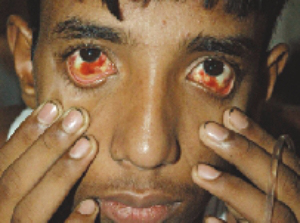Dengue, also called break-bone fever, is an arborvirus spread by the Aedes aegypti mosquito, which I normally do not encounter in my The Woodlands dermatology and Conroe dermatology offices. It is endemic to Southeast Asia but can be found in tropical regions around the world. Within two weeks of being bitten by the Aedes mosquito, patients develop a very high fever, headache, back pains, joint and bone pains, pain behind the eye (retroorbital pain), fatigue and depression. A morbilliform erythematous (red) rash occurs on the chest, back and joint flexors. Some patients recover completely at this point but some develop a second rash that is very purpuric (bruise like) around the 3rd to 4th day after the first rash began. A characteristic of this second purpuric rash are small “white islands in a sea of red” of spared skin which appear normal surrounded by the rash. In 5% of patients, Dengue Hemorrhagic Fever occurs. Thromboctyopenia (low platelets) develops which results in spontaneous bleeding in the skin, conjunctiva of the eyes, and gastrointestinal tract. Approximately 30% of patients with Dengue Hemorrhagic Fever, progress to Dengue Shock Syndrome. Dengue Shock Syndrome is fatal in 10% of patients as hypotension results secondary to hypovolemia.






